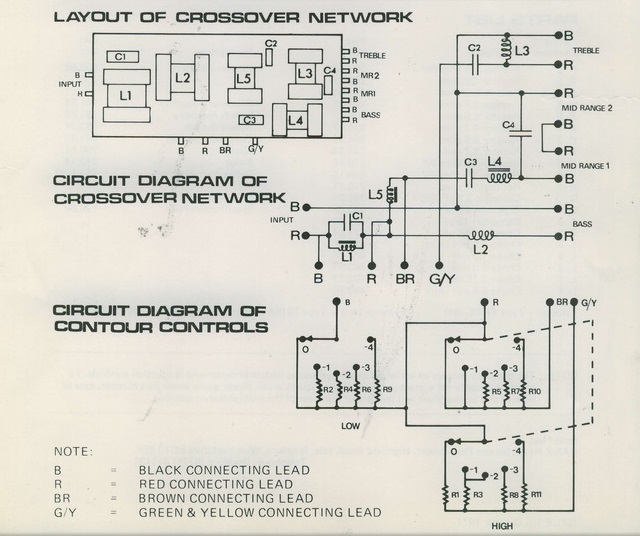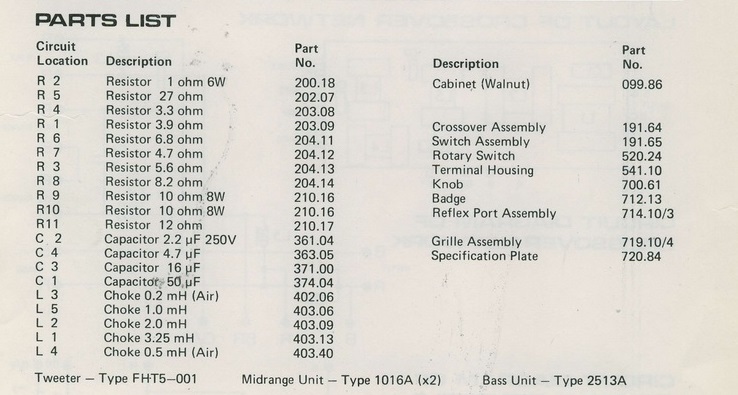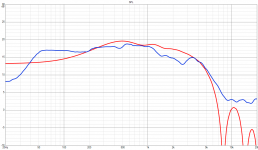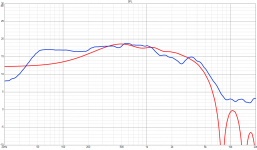Hi all, I am wondering how Wharfedale managed to avoid Baffle step issue in their excellent E70 loudspeakers. I owned these beasts for 10 enjoyable years in the 80's until I regrettably had to sell them.
The woofers are crossed at 700 hz and the front baffe is 340mm wide and 815mm high. Any explanations? Enclosed some scanned docs that I have preciously kept from the DIY speakercraft manual.
The woofers are crossed at 700 hz and the front baffe is 340mm wide and 815mm high. Any explanations? Enclosed some scanned docs that I have preciously kept from the DIY speakercraft manual.
Attachments
Did you use them against or close to the wall, in which case baffle step compensation would not be essential?
My friend has his E50s located in corner positions to good effect.
My friend has his E50s located in corner positions to good effect.
It's possible they used level differences between ways, though it might take some simming to be sure.
I placed them 50 cm from rear wall and more than 1 m from side walls. I still remember that they were good sounding anywhere I placed them, with a just a slight loss of bass.
I just noticed in the diy kit manual that all their 3 ways in the L80 and L100 kits were cut at 650 and 700 hz. Bizarre???
I just noticed in the diy kit manual that all their 3 ways in the L80 and L100 kits were cut at 650 and 700 hz. Bizarre???
Old scholl...nowadays it's more 'two way + sub' than 'woofer+squeaker+tweeter'.
Though 'sub' shouldn't cover more than 100Hz..but you get the idea- you use a midbass for the midrange and the rest follows
Though 'sub' shouldn't cover more than 100Hz..but you get the idea- you use a midbass for the midrange and the rest follows
Those are nice drivers. I had the LF drivers in a large 2 way with audax tw034s ala A25 clones.
The LF Mms was only 30g and likely enough Le to avoid BSC. Baffle size and crossover frequency were set to take advantage of where upper rolloff happened to land. Back then drivers were optimized for OEM applications using simple filter networks, which would end up sounding very good in contrast to nowadays taking drivers with wayward FR curves and filtering them to death, stuffing them into small 2 way boxes.
The LF Mms was only 30g and likely enough Le to avoid BSC. Baffle size and crossover frequency were set to take advantage of where upper rolloff happened to land. Back then drivers were optimized for OEM applications using simple filter networks, which would end up sounding very good in contrast to nowadays taking drivers with wayward FR curves and filtering them to death, stuffing them into small 2 way boxes.
Calculating the baffle area setting on and perpendicular to, the floor = ~ 49 Hz/F6, so is basically in-wall mounted over most of its usable BW.
I've been [and will continue to be when appropriate] a 'broken record' about using wide/large enough baffles even if just [folding] 'wings' to obviate the need for BSC, though understand that it's not a viable option for most folks nowadays.
I've been [and will continue to be when appropriate] a 'broken record' about using wide/large enough baffles even if just [folding] 'wings' to obviate the need for BSC, though understand that it's not a viable option for most folks nowadays.
Do you have the TS parameters of the woofer? If neg can anyone provide them?Those are nice drivers. I had the LF drivers in a large 2 way with audax tw034s ala A25 clones.
The LF Mms was only 30g and likely enough Le to avoid BSC. Baffle size and crossover frequency were set to take advantage of where upper rolloff happened to land. Back then drivers were optimized for OEM applications using simple filter networks, which would end up sounding very good in contrast to nowadays taking drivers with wayward FR curves and filtering them to death, stuffing them into small 2 way boxes.
I would like to do some post mortem xover sims.
I mean sims in winisd. I wonder if frd and zma are available. They would be most welcome.
I am still intrigued by the high low pass cutoff of 700Hz.
I am still intrigued by the high low pass cutoff of 700Hz.
That means that at that frequency the woofer is 6 dB down, depending on filter slope. i guess it's a 12 dB/2nd order filter
According to the loudspeaker FR in the chart attached, seemingly there is no db loss in the lower region. How is it possible???
Note that the setting related to the measurement is not mentionned, was it in normal room listening condition or in an anechoic environment???
Is there any former Rank /wharfedale member in the diyforum who can give us the explanation? A 10 inch woofer on a 34 cm wide baffle and no baffle step ?...... Astonishingly baffling!!
Note that the setting related to the measurement is not mentionned, was it in normal room listening condition or in an anechoic environment???
Is there any former Rank /wharfedale member in the diyforum who can give us the explanation? A 10 inch woofer on a 34 cm wide baffle and no baffle step ?...... Astonishingly baffling!!
Attachments
I decided to put this response up against a sim of some baffle step, because it does slightly fall toward the bass and look like it hasn't been dealt with.
Looking at this, a few things come to mind in reconciling the baffle step. One, that the 500-1kHz response might be brought down by the filter meaning the sim plot should be shifted up a little. Also, that the bass resonance could have been designed to be high.. and, where it falls out near 200Hz is near to the Schroeder frequency and you could just put them in a helpful position.
Looking at this, a few things come to mind in reconciling the baffle step. One, that the 500-1kHz response might be brought down by the filter meaning the sim plot should be shifted up a little. Also, that the bass resonance could have been designed to be high.. and, where it falls out near 200Hz is near to the Schroeder frequency and you could just put them in a helpful position.
Attachments
Unsurprisingly, there were some minor variations on the Wharfedale E70. One I looked at had 3.2mH bass coil rather than 2mH. Claimed to be "maximally flat 4th. order butterworth".
Here's a few images from my archive.
The speaker had series wired twin 8 ohm mids and some "contour" or level controls.
The LC trap on the bass unit controls the midbass presence. The mid and tweeter have a ganged level adjust. Quite heavy going to sort out what it all does.
I came up with a simplified circuit (last) that shows the essentials for anyone interested in recreating the style. But actually fairly conventional 3-way.
Here's a few images from my archive.
The speaker had series wired twin 8 ohm mids and some "contour" or level controls.
The LC trap on the bass unit controls the midbass presence. The mid and tweeter have a ganged level adjust. Quite heavy going to sort out what it all does.
I came up with a simplified circuit (last) that shows the essentials for anyone interested in recreating the style. But actually fairly conventional 3-way.
Attachments
Great archive material Steve!
It shows that the crossover in the factory built E70 is a tad more complicated than the crossover in the E70 kit version illustrated by the OP.
It shows that the crossover in the factory built E70 is a tad more complicated than the crossover in the E70 kit version illustrated by the OP.
I was just reviewing this. Sorry the circuit is so hard to read... PNG was no better when uploaded.


The main bass coil IS 2mH! I was wrong. Across the LC (L1, C1) trap are resistors 0, 1, 3.3, 6.8, 10. (0-4)
The extra midrange 1mH L5 coil gets shunt resistors 0, 0, 27, 4.7, 10. (0-4)
The tweeter gets a simple series 3.9, 5.6, 5.6, 8.2, 12. (0-4)
I think the adjustable bass contour is for more bafflestep. Then you take the rest down to match.
The main bass coil IS 2mH! I was wrong. Across the LC (L1, C1) trap are resistors 0, 1, 3.3, 6.8, 10. (0-4)
The extra midrange 1mH L5 coil gets shunt resistors 0, 0, 27, 4.7, 10. (0-4)
The tweeter gets a simple series 3.9, 5.6, 5.6, 8.2, 12. (0-4)
I think the adjustable bass contour is for more bafflestep. Then you take the rest down to match.
Last edited:
My E70s were the simplified kit version and were perfect (imo) and never tiring, at a time when I was in my thirty's and my ears had their full hearing capacities.
As compared to now only 50-14 khz. What a pity......fortunately the Hifi passion never fades
As compared to now only 50-14 khz. What a pity......fortunately the Hifi passion never fades
It seems that what you had was a Wharfedale E70 with the contour controls set at 0 or flat.
My flatmate had these speakers, and I thought they were superb.
IMO, the secret sauce was the twin mids wired in series. This made for a good high impedance and low distortion and good projection of the all important voices. It is interesting that twin drivers have the same level as single ones, but put only half the power into the room.
My flatmate had these speakers, and I thought they were superb.
IMO, the secret sauce was the twin mids wired in series. This made for a good high impedance and low distortion and good projection of the all important voices. It is interesting that twin drivers have the same level as single ones, but put only half the power into the room.
- Home
- Loudspeakers
- Multi-Way
- Baffle step mystery- Wharfedale E70 vintage












